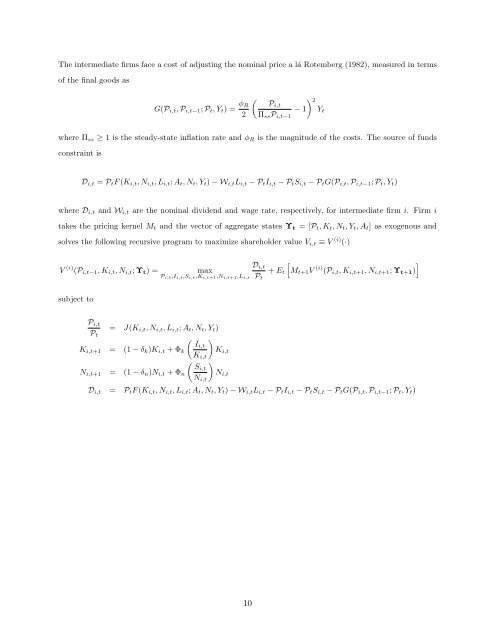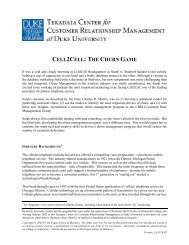Equilibrium Growth, Inflation, and Bond Yields - Duke University's ...
Equilibrium Growth, Inflation, and Bond Yields - Duke University's ...
Equilibrium Growth, Inflation, and Bond Yields - Duke University's ...
You also want an ePaper? Increase the reach of your titles
YUMPU automatically turns print PDFs into web optimized ePapers that Google loves.
The intermediate firms face a cost of adjusting the nominal price a lá Rotemberg (1982), measured in terms<br />
of the final goods as<br />
G(Pi,t, Pi,t−1; Pt, Yt) = φR<br />
2<br />
� Pi,t<br />
ΠssPi,t−1<br />
�2 − 1 Yt<br />
where Πss ≥ 1 is the steady-state inflation rate <strong>and</strong> φR is the magnitude of the costs. The source of funds<br />
constraint is<br />
Di,t = PtF (Ki,t, Ni,t, Li,t; At, Nt, Yt) − Wi,tLi,t − PtIi,t − PtSi,t − PtG(Pi,t, Pi,t−1; Pt, Yt)<br />
where Di,t <strong>and</strong> Wi,t are the nominal dividend <strong>and</strong> wage rate, respectively, for intermediate firm i. Firm i<br />
takes the pricing kernel Mt <strong>and</strong> the vector of aggregate states Υt = [Pt, Kt, Nt, Yt, At] as exogenous <strong>and</strong><br />
solves the following recursive program to maximize shareholder value Vi,t ≡ V (i) (·)<br />
V (i) �<br />
Di,t<br />
(Pi,t−1, Ki,t, Ni,t; Υt) = max<br />
+ Et Mt+1V<br />
Pi,t,Ii,t,Si,t,Ki,t+1,Ni,t+1,Li,t Pt<br />
(i) �<br />
(Pi,t, Ki,t+1, Ni,t+1; Υt+1)<br />
subject to<br />
Pi,t<br />
= J(Ki,t, Ni,t, Li,t; At, Nt, Yt)<br />
�<br />
Pt<br />
�<br />
Ii,t<br />
Ki,t+1 = (1 − δk)Ki,t + Φk<br />
Ki,t<br />
�<br />
Si,t<br />
Ni,t+1 = (1 − δn)Ni,t + Φn<br />
Ni,t<br />
�<br />
Ki,t<br />
Ni,t<br />
Di,t = PtF (Ki,t, Ni,t, Li,t; At, Nt, Yt) − Wi,tLi,t − PtIi,t − PtSi,t − PtG(Pi,t, Pi,t−1; Pt, Yt)<br />
10
















